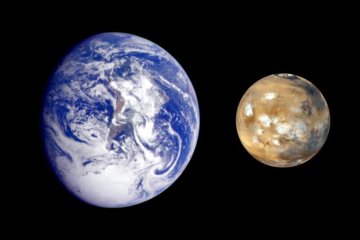All genres
1.
Journal Article
The nucleus of Comet 22P/Kopff and its inner coma. Icarus 156 (2), pp. 442 - 455 (2002)
2.
Journal Article
Observations of the trans-neptunian objects 1993 SC and 1996 TL66 with the Infrared Space Observatory. Astrophysical Journal 534, pp. 446 - 455 (2000)
3.
Journal Article
Observations of the Kuiper Belt Objects 1993 SC and 1996 TL66 with ISO. Astrophysical Journal 534, pp. 446 - 455 (2000)
4.
Journal Article
Effect of diffuse sky brightness on the spectrophotometry of rough Martian surfaces. Journal Geophysical Research 105 (E11), pp. 26739 - 26744 (2000)
5.
Journal Article
Dust morphology of comet Hale-Bopp (C/1995 01): I. Pre-perihelion coma structures in 1996. Earth, Moon and Planets 78, pp. 179 - 187 (1999)
6.
Journal Article
Comet C/1996 B2 Hyakutake: observations, interpretation and modelling of the dynamics of fragments of cometary nuclei. Mon. Not. R. Astron. Soc. 303, pp. 826 - 834 (1999)
7.
Journal Article
Production and kinematics of sodium atoms in the coma of comet Hale-Bopp. Astronomy and Astrophysics 334, pp. L53 - L56 (1998)
8.
Journal Article
Can the sodium tail of comet Hale-Bopp have a dust-impact origin? Astrophysical Journal 496, pp. L47 - L49 (1998)
9.
Journal Article
The nucleus and inner coma of comet 46P/Wirtanen. Astronomy and Astrophysics 335, pp. L25 - L29 (1998)
10.
Journal Article
The rotation period of C/1995 01 (Hale-Bopp). Astrophysical Journal 501, pp. L221 - L225 (1998)
11.
Journal Article
Comet 46P/Wirtanen, the target of the Rosetta mission. Advances in Space Research 21 (11), pp. 1491 - 1504 (1998)
12.
Journal Article
Comet Hyakutake Gas Arcs: First Observational Evidence of Standing Shock Waves in a Cometary Coma. Icarus 136, pp. 232 - 267 (1998)
13.
Journal Article
OSIRIS - The optical spectroscopic and infrared remote imaging for the Rosetta orbiter. Advances in Space Research 21, pp. 1505 - 1515 (1998)
14.
Journal Article
Dust morphology of comet Hale-Bopp (C/1995 O1): I. pre-perihelion coma structures in. Earth, Moon and Planets 78, pp. 179 - 187 (1997)
15.
Journal Article
Long-term UBVRI monitoring of 12 southern hemisphere Long Period Variables. Astronomy and Astrophysics, Suppl. Ser. 122, pp. 415 - 432 (1997)
16.
Journal Article
The rotational parameters of Hale-Bopp from observations of the dust jets at Pic du Midi Observatory. Earth, Moon and Planets 77, pp. 167 - 180 (1997)
17.
Journal Article
The spin axis position of C/1995 O1 (Hale-Bopp). Earth, Moon and Planets 77, pp. 199 - 206 (1997)
18.
Journal Article
Optical observations of Comet Hale-Bopp (C/1995 O1) at large heliocentric distances before perihelion. Science 275, pp. 1909 - 1912 (1997)
19.
Journal Article
Millimetric and optical observations of Chiron. Planetary and Space Science 45, pp. 799 - 805 (1997)
20.
Journal Article
Evidences for extended sources and temporal modulations in molecular observations of C/1995 O1 (Hale-Bopp) at the IRAM interferometer. Earth, Moon and Planets 78, p. 63 - 63 (1997)











